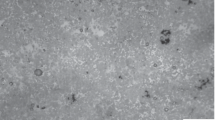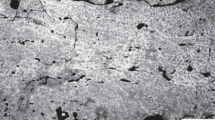Abstract
The analysis of modern approaches in choosing compositions of cermets based on TiC carbide and Ni matrix doped with additional Mo, W, Cr, Nb, and Ta carbides is carried out. The hardness and transverse strength of the cermets based on TiC carbide and Ni matrix increases with the use of additional Mo, W, Cr carbides owing to the formation of an annular zone around TiC. The calculated microhardness of carbides in the cermet increases with an increase in their volume fraction and with the use of Mo, W, and Cr carbides. On the basis of an analysis of the literature, TiC–Cr3C2–WC–TiB2–SiC–Mo–B–Si–Ni cermets with additional carbon content for plasma coatings are proposed and studied. Mechanical alloying and liquid phase sintering at temperatures of 950, 1250, and 1450°C are used to evenly distribute the carbides in the base phase and to establish strong bonds between them with high values of microhardness, up to 2438 kgf/mm2 at a load on the indenter of 20 G and 2030 kgf/mm2 at a load on the indenter of 200 G. The maximum values of microhardness are obtained at higher sintering temperatures at which the minimum content of oxygen is fixed. The positive effect of carbides based on W, Mo, and Cr on the organization of a strong titanium carbide compound with a base phase is confirmed experimentally, which is proved by the calculated value of the contribution of microhardness of TiC carbide to the cermet microhardness. At a volume fraction of the carbides of 77% and a load on the indenter of 20 G, the contribution of microhardness of the carbide is equal to 2906 kgf/mm2, which is close to the TiC hardness of 3200 kgf/mm2. This contribution of microhardness is equal to 2145.5 kgf/mm2 at a load on the indenter of 200 G.




Similar content being viewed by others
REFERENCES
Fal’kovskii, V.A. and Klyachko, L.I., Tverdye splavy (Hard Alloys), Moscow: Ruda i Metally, 2005.
Tolstobrov, A.K., Mitrofanov, B.V., and Zashlyapin, M.Yu., Effect of the binder metal on the strength and wear resistance of plasma coatings based on titanium and titanium-zirconium carbonitrides, Powder Metall. Met. Ceram., 1992, vol. 31, no. 11, pp. 948–952.
Wang, X., Zou, Z., Song, S., and Qu, S., Microstructure and wear properties of in situ TiC/FeCrBSi composite coating prepared by gas tungsten arc welding, Wear, 2006, vol. 260, pp. 705–710.
Podchernyaeva, I.A., Kisel’, V.M., Evdokimenko, Yu.I., Lavrenko, V.A., and Pasichnyi, V.V., Investigation of a wear-and corrosion-resistant coating of the TiCN–Ni-alloy system, obtained by high-speed gas-flame spraying, Powder Metall. Met. Ceram., 1999, vol. 38, no. 7, pp. 358–361.
Tian, L.-H., Li, C.-X., Li, C.-J., and Yang, G.-J., Effect of dispersed TiC content on the microstructure and thermal expansion behavior of shrouded-plasma-sprayed FeAl/TiC composite coatings, J. Therm. Spray Technol., 2012, vol. 21, nos. 3–4, pp. 689–694.
Borisov, Yu.S. and Kharlamov, Yu.A., Gazotermicheskie pokrytiya iz kompozitsionnykh poroshkov. Spravochnik (Gas-Thermal Coatings of Composite Powders: Handbook), Kiev: Naukova Dumka, 1987.
Xi, W.-J., Li, N., Zhang, T., Zhu, W.-L., and Guo, H.-Z., Thermite reaction synthesis of nanosized NiAl reinforced FeNiCr–TiC composite coating, J. Alloys Compd., 2010, vol. 504S, pp. S414–S417.
Koroleva, E.B., Klinskaya, N.A., Rybalko, O.F., and Ugol’nikova, T.A., Plasma metallization of refractory carbide powders, Fiz. Khim. Obrab. Mater., 1986, no. 6, pp. 57–60.
Tsidulko, A.G., Rusanov, V.M., Bobrov, G.V., Dokukina, I.A., Timofeev, I.I., and Shaposhnikova, T.I., Loss of carbon during plasma-spraying of clad carbide powders, Powder Metall. Met. Ceram., 1992, vol. 31, no. 10, pp. 883–885.
Kalita, V.I., Radyuk, A.A., Komlev, D.I., Ivannikov, A.Yu., Mikhailova, A.B., Alpatov, A.V., Kasimtsev, A.V., Chuyeva, T.R., Umnova, N.V., and Titov, D.D., Cermet plasma coatings based on silicon carbide, Inorg. Mater.: Appl. Res., 2019, vol. 10, no. 5, pp. 1145–1152. https://doi.org/10.1134/S2075113319050095
Kalita, V.I., Radyuk, A.A., Komlev, D.I., Ivannikov, A.Yu., Mikhailova, A.B., and Alpatov, A.V., Cermet plasma TiC–Cr3C2–NiCr–Mo–C coatings, Inorg. Mater.: Appl. Res., 2019, vol. 10, no. 2, pp. 402–410. https://doi.org/10.1134/S2075113319020205
Berger, L.-M., Application of hard metals as thermal spray coatings, Int. J. Refract. Met. Hard Mater., 2015, vol. 49, pp. 350–364.
Raitsess, V.B., Litvin, V.M., Rutberg, V.P., Nagorskaya, Z.S. and Brazhevskii, V.P., Wear-resistant plasma coatings based on a double carbide of titanium and chromium, Powder Metall. Met. Ceram., 1986, vol. 25, no. 10, pp. 827–828.
Hussainova, I. and Antonov, M., Assessment of cermets performance in erosive media, Int. J. Mater. Prod. Technol., 2007, vol. 28, nos. 3–4, pp. 361–376.
Umanskyi, O., Poliarus, O., Ukrainets, M., Antonov, M., and Hussainova, I., High temperature sliding wear of NiAl-based coatings reinforced by borides, Mater. Sci., 2016, vol. 22, no. 1, pp. 14–19.
Stoica, V., Ahmed, R., Itsukaichi, T., and Tobe, S., Sliding wear evaluation of hot isostatically pressed (HIPed) thermal spray cermet coatings, Wear, 2004, vol. 257, pp. 1103–1124.
Jin, C., Onuoha, C.C., Farhat, Z.N., Kipouros, G.J., and Plucknett, K.P., Reciprocating wear behaviour of TiC stainless steel cermets, Tribol. Int., 2017, vol. 105, pp. 250–263.
Acharya, S., Debata, M., Acharya, T.S., Acharya, P.P., and Singh, S.K., Influence of nickel boride addition on sintering behavior and mechanical properties of TiCNi based cermets, J. Alloys Compd., 2016, vol. 685, pp. 905–912.
Kiparisov, S.S., Levinskii, Yu.V., and Petrov, A.P., Karbid titana: poluchenie, svoistva, primenenie (Titanium Carbide: Production, Properties, and Application), Moscow: Metallurgiya, 1987.
Wana, W., Xiong, J., and Liang, M., Effects of secondary carbides on the microstructure, mechanical properties and erosive wear of Ti(CN)-based cermets, Ceram. Int., 2017, vol. 43, pp. 944–952.
Zheng, Y., You, M., Xiong, W., Liu, W., and Wang, S., Effect of Cr3C2 on valence-electron structure and plasticity of rim phase in Ti(C,N)-based cermets, J. Am. Ceram. Soc., 2004, vol. 87, no. 3, pp. 460–464.
Xiong, H., Li, Z., and Zhou, K., TiC whisker reinforced ultra-fine TiC-based cermets: Microstructure and mechanical properties, Ceram. Int., 2016, vol. 42, pp. 6858–6867.
Yang, Q., Xiong, W., Zhang, M., Huang, B., and Chen, S., Microstructure and mechanical properties of Mo-free Ti(C,N)-based cermets with Ni–xCr binders, J. Alloys Compd., 2015, vol. 636, pp. 270–274.
Zhou, W., Zheng, Y., Zhao, Y., Ma, Y., and Xiong, W., Microstructure characterization and mechanical properties of Ti(C,N)-based cermets with AlN addition, Ceram. Int., 2015, vol. 41, pp. 5010–5016.
Zhang, Y., Zheng, Y., Zhong, J., Yuan, Q., and Wu, P., Effect of carbon content and cooling mode on the microstructure and properties of Ti(C,N)-based cermets, Int. J. Refract. Met. Hard Mater., 2009, vol. 27, pp. 1009–1013.
Zhan, B., Liu, N., Jin, Z.B., Li, Q., and Shi, J.G., Effect of VC/Cr3C2 on microstructure and mechanical properties of Ti (C, N)-based cermets, Trans. Nonferrous Met. Soc. China, 2012, vol. 22, no. 5, pp. 1096–1105.
Holmes, M., Electrochemical behavior of Ti(C, N) and TiC cermets, PhD Thesis, Halifax: Dalhousie Univ., 2012.
Akimov, V.V., Kul’kov, S.N., Panin, V.E., and Gorlach, V.V., Effect of boron on the phase composition of TiC–TiNi alloys, Soc. Powder Metall. Met. Ceram., 1985, vol. 24, no. 8, pp. 637–639.
Jõeleht, M., et al., The influence of high energy milling and sintering parameters on reactive sintered (Ti, Mo) C–Ni cermets, J. Alloys Compd., 2015, vol. 636, pp. 381–386.
Zhang, W.N., Wang, H.Y., Wang, P.J., Zhang, J., He, L., and Jiang, Q.C., Effect of Cr content on the SHS reaction of Cr–Ti–C system, J. Alloys Compd., 2008, vol. 465, pp. 127–131.
Rödiger, O., Zur Kenntnis des Systems Wolframkarbid–Titankarbid–Chromkarbid, Metallurgie, 1953, vol. 7, pp. 967–969.
Wan, W., Xiong, J., Yang, M., Guo, Z., Dong, G., and Yi, C., Effects of Cr3C2 addition on the corrosion behavior of Ti(CN)-based cermets, Int. J. Refract. Met. Hard Mater., 2012, vol. 31, pp. 179–186.
Manoj Kumar, B.V., Basuw, B., et al., Erosion wear behavior of TiCN–Ni cermets containing secondary carbides WC/NbC/TaC, J. Am. Ceram. Soc., 2006, vol. 89, no. 12, pp. 3827–3831.
Pirso, J., Viljus, M., and Letunovits, S., Friction and dry sliding wear behavior of cermets, Wear, 2006, vol. 260, pp. 815–824.
Lyphout, C., Bolelli, G., Smazalova, E., Sato, K., Yamad, J., Houdkovác, S., Lusvarghi, L., and Manfredini, T., Influence of hardmetal feedstock powder on the sliding wear and impact resistance of high velocity air-fuel (HVAF) sprayed coatings, Wear, 2019, vols. 430–431, pp. 340–354.
Funding
This work was supported by the Russian Foundation for Basic Research, project no. 20-08-00059 A. The study of the contents of carbon, oxygen, and nitrogen in the cermets was carried out within the scope of the initiative subject of the Baikov Institute of Metallurgy and Materials Science, Russian Academy of Sciences, 075-00947-20-00.
Author information
Authors and Affiliations
Corresponding authors
Additional information
Translated by L. Mukhortova
Rights and permissions
About this article
Cite this article
Kalita, V.I., Radyuk, A.A., Komlev, D.I. et al. TiC–Cr3C2–WC–TiB2–SiC-Based Cermets. Inorg. Mater. Appl. Res. 11, 1199–1213 (2020). https://doi.org/10.1134/S2075113320050159
Received:
Revised:
Accepted:
Published:
Issue Date:
DOI: https://doi.org/10.1134/S2075113320050159




